This glossary page was updated on September 14, 2022.
Today’s customers enter the marketing and sales funnel at various points.
Some are poised to buy—they book a demo, love your product, and sign up for a paid plan. Others are a little further up the funnel—they spend some time reading your blog posts and maybe download an ebook, but they aren’t ready for a sales discussion yet.
And, of course, anywhere in between exists as well.
The question is, how do we get customers with minimal intent down the funnel and into the hands of your sales team?
Drip campaigns are a great tactic here, allowing you to fire off a series of targeted emails en masse and on repeat.
This article will cover a few drip campaign fundamentals before diving into a 7-step guide to building your own.
Table of contents
- What is a drip campaign?
- Why should you use drip campaigns?
- How to develop a high-performing email drip campaign
- Frequently asked questions
What is a drip campaign?
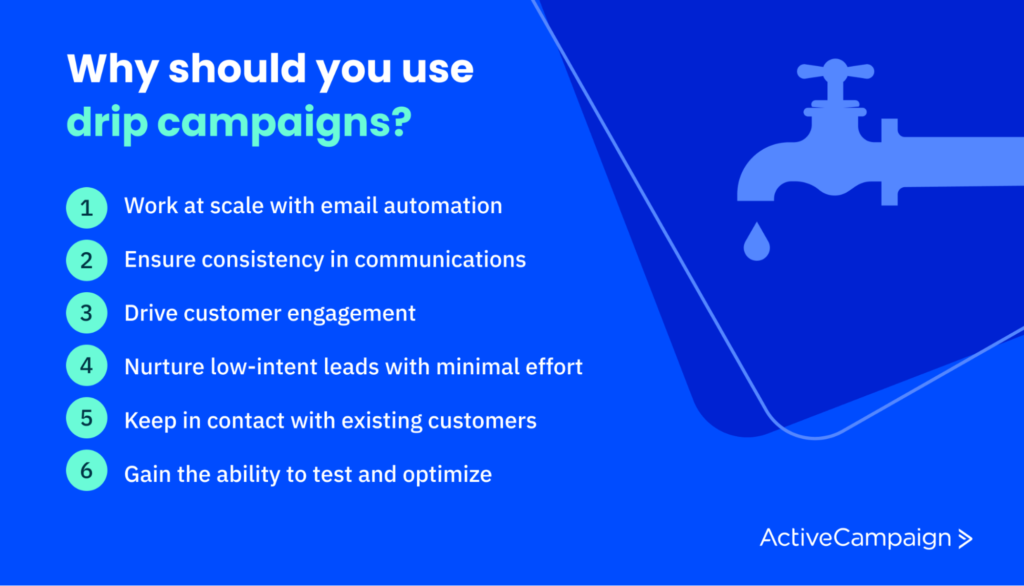
A drip campaign is an automated series of marketing emails sent to a customer (in a specific order) based on a specific action they’ve taken.
For example, let’s say a customer recently signed up for a free trial. They then receive an email like the 1 below, which is the first in a drip campaign designed to educate the customer on how to use your platform.
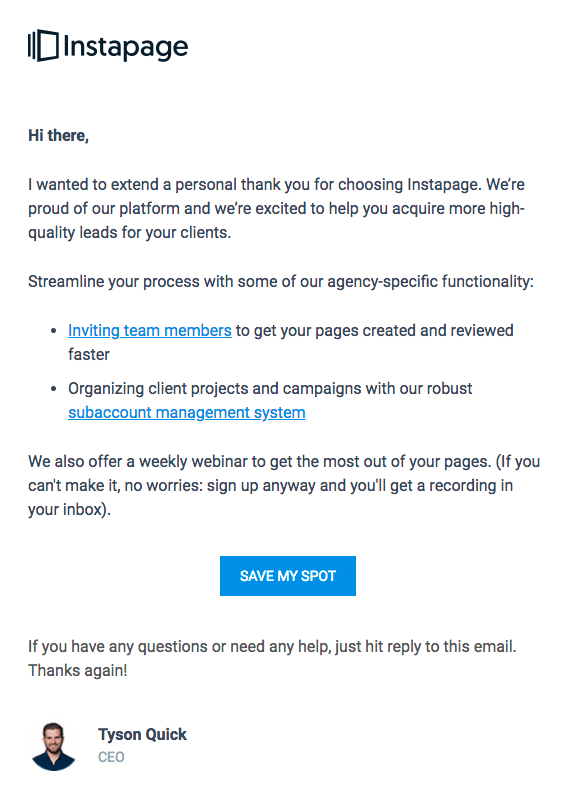
For the most part, customers on an email list don’t even realize they’re in a drip campaign: the idea is to make the content look contextual and relevant to their needs.
However, drip campaigns can be intentional if customers opt into a specific email chain, like this:
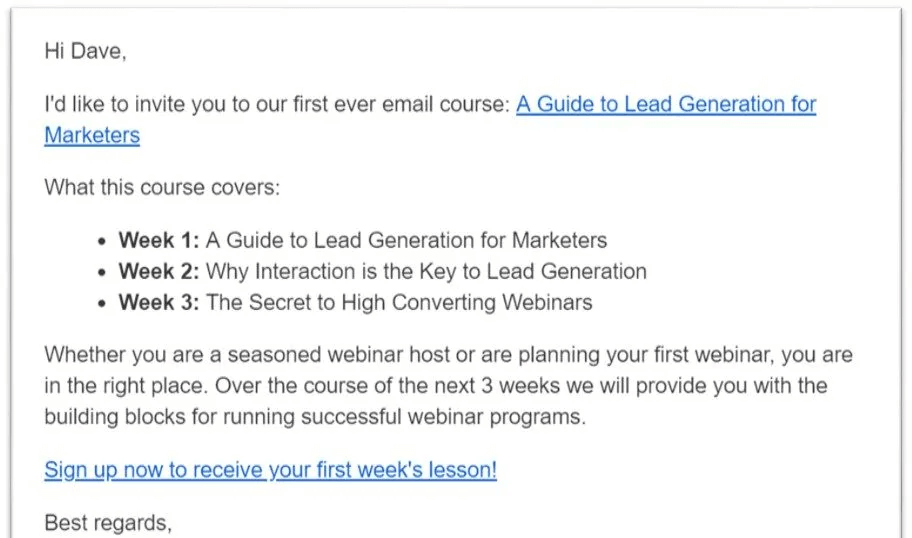
Automated email marketing, automated email campaigns, and email nurture campaigns are all essentially synonyms for drip campaigns.
How do drip campaigns work?
From the customer’s perspective, drip campaigns look like a new email every day or week (or whatever other interval you choose).
However, things are a little more complex on the marketer’s end.
First, you need to capture a customer’s email address. This is generally done through a lead magnet, like an ebook.
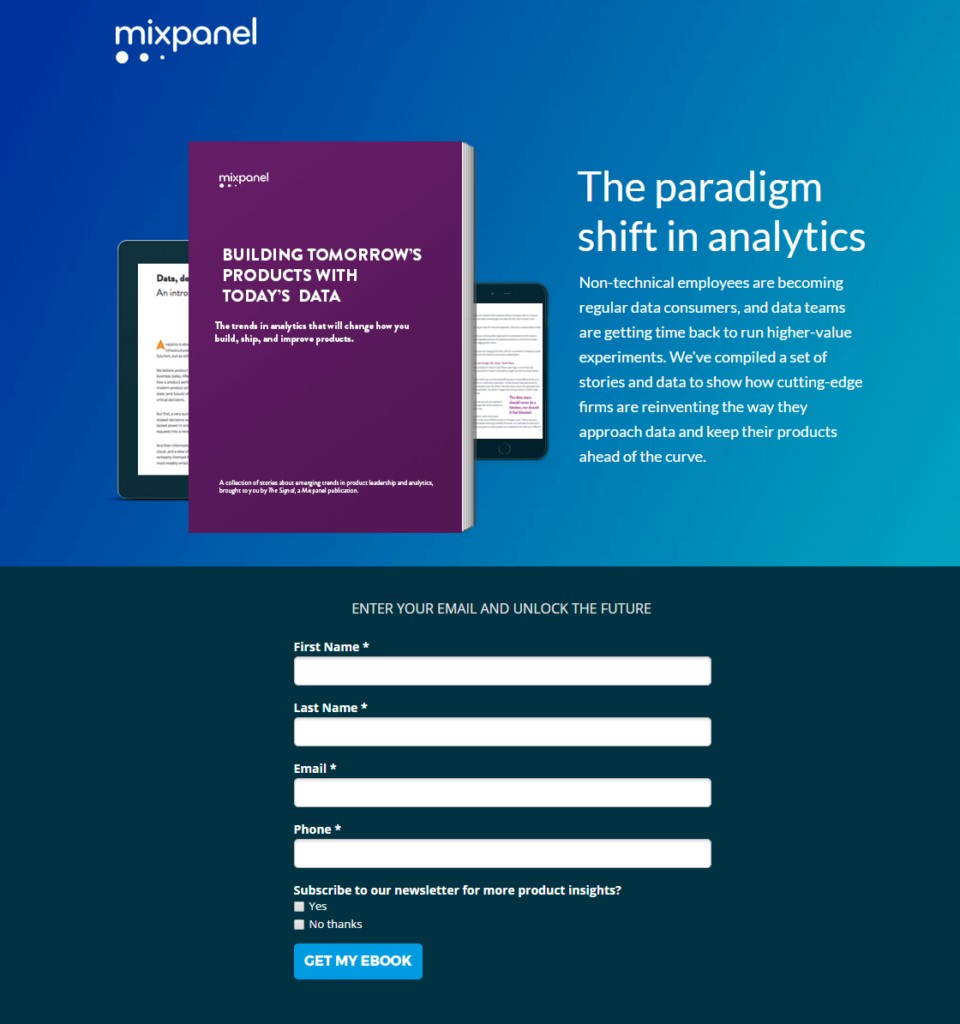
Now that you have the customer’s data, they get assigned to a drip campaign in your email marketing platform.
For now, you might only have 1 drip campaign (for those who’ve downloaded your ebook). Over time, however, you’ll develop a number of campaigns for different purposes, so you’ll need to build automation into your email platform, so new leads are routed to the right campaign.
From there, it’s all hands-off.
Customers will continue to receive emails according to the parameters you set. Perhaps they’ll receive 1 a week for six weeks; maybe it will be 1 every day for 2 weeks—it’s really up to you.
You’ve also got a few choices for the drip campaign’s end.
Customers can automatically move from 1 drip campaign to another, or you might decide to simply stop emailing them. In addition, your email automation platform should allow you to stop drip campaigns once a customer takes a specific action.
For instance, you might have a lead nurture drip campaign to encourage readers to book a sales demo.
Once they click that call-to-action (CTA) and book that demo, they don’t need to see the rest of the email content in that campaign, so you can build an automation rule so that the customer is instantly removed from your drip campaign.
Why should you use drip campaigns?
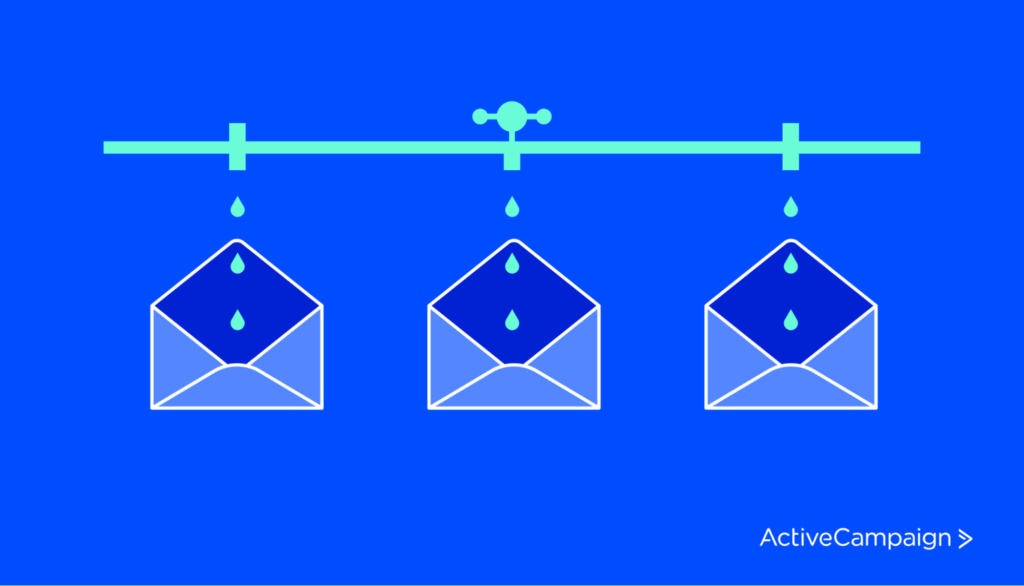
Drip emails offer many crucial benefits for ambitious marketers with large target audiences to serve and new prospective customers pouring in daily.
1. Work at scale with email automation
Email automation is a non-negotiable for high-volume marketing.
Say you’ve got an email database of 10,000 customers (reasonable, but not huge either). Are you going to be able to keep in touch with each of them using a traditional email client like Gmail?
No.
Automated drip campaigns help you communicate with customers en masse without having to lift a finger.
2. Ensure consistency in communications
Drip campaigns ensure the same message gets to every single customer. That means your communications are consistent and reduce the likelihood of human error.
3. Drive customer engagement
Engaging with customers is a 2-way effort. You can’t expect them to return the favor if you’re not effectively communicating with them.
Automated drip campaigns make this process easier. As soon as a customer takes a specific action, they’re scheduled for several weeks’ worth of email communications. Easy.
4. Nurture low-intent leads with minimal effort
Sales reps should focus their time on the most urgent opportunities, which often means that low-intent prospects simply get ignored.
Drip campaigns can be a great way to keep the communication line open with those who aren’t ready to buy yet.
5. Keep in contact with existing customers
Don’t forget that your biggest opportunity for revenue growth is those customers who’ve already purchased from you!
While your marketing and sales efforts focus on attracting new customers, automated drip campaigns can keep existing clients returning, driving repeat purchases, and reducing customer churn rates.
6. Gain the ability to test and optimize
Because drip campaigns are automated and en masse, they’re perfect candidates for experimental tests.
For example, you can easily A/B test 1 email style against another, making it easy to optimize your messaging.
What should a drip campaign include?
At a minimum, drip campaigns require:
- Email copy and headlines
- Any other creative elements (like images and video to be included in your email)
- A timeline for campaign scheduling
You’ll also need a robust email marketing automation tool to manage everything.
But you’ve got a few steps before getting into that.
First, you’ll need to engage in deep audience research to understand who you’re communicating with and what they need from you. You’ll then need to develop audience segments, decide on the goal of your various drip campaigns, and build a plan for measuring the whole thing.
In the next section, we’ll walk you through all of those.
How to develop a high-performing email drip campaign
Okay, now you’re clear on how drip campaigns work and why they’re important.
How exactly do you go about building one?
1. Use customer research to segment your audience
The best-performing drip campaigns are based on a strong understanding of your audience, what ails them, and what drives them to purchase (or to keep purchasing).
Important to note here, however, that not every customer will have the same needs, meaning to be as effective as possible, you’ll need to segment audiences based on specific traits.
Start by performing audience research and building buyer personas. Then, attach attributes to each lead or customer in your email marketing tool for easy segmentation moving forward.
2. Understand intent to build relevant campaigns
You’re likely to build out several drip campaigns, which should be based entirely on the intent signaled by your customer during their initial interaction.
For example, a customer downloading a “State of the Industry” ebook from your website isn’t exactly giving a purchase intent signal, so putting them into a campaign that promotes your product features wouldn’t be a good fit.
In this case, you’d be better off nurturing that lead with educational content and possibly funneling them into a more product-focused campaign later, depending on their engagement signals.
3. Build out your drip campaign blueprint
Once you’ve got your head around key customer challenges, needs, desires, attributes, and intents, it’s time to design a campaign blueprint.
This involves drawing a high-level map for the email content you’ll include in the campaign and any user actions that might impact the specific drip campaign emails they receive.
Here’s an example of what the start of 1 of these blueprints would look like for a sales drip campaign.
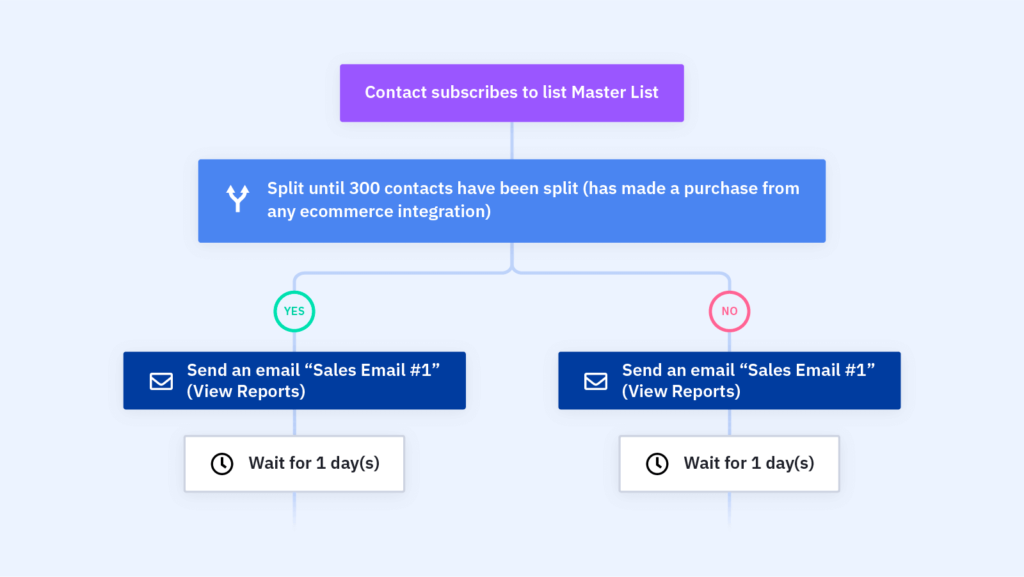
4. Get clear on your campaign goals
Next, set clear goals for each of your campaigns.
Ask: what is the goal for this campaign? What action do we want our customers to take at the end of this campaign?
For instance, at the end of a sales drip campaign like the above, the goal might be to have the customer sign up for a free trial.
Gain clarity on your drip campaign goals, then…
5. Design a plan for measuring campaign success
Now that you’ve set your goals, how will you manage progress against them?
In this step, you’ll need to determine which metrics you’ll use to measure campaign success and set some KPIs to track progress.
Let’s take the above example: our goal is to have customers sign up for a free trial.
So, our metric here would be New Trial Users, and we might set a KPI of 5% conversion from the drip campaign.
6. Take advantage of automation to run fast
Drip campaigns are all about having things run on repeat.
So, beyond simply automating the campaign itself, consider how else you can use this helpful feature to your advantage.
You can, for instance, automate:
- Potential customers (leads) moving from 1 campaign to another
- Dynamic content based on audience characteristics
- Campaigns to stop when customers take the desired action
7. Be prepared to test, iterate, and optimize
Lastly, it’s important to remember that drip email campaigns should never be a set-and-forget affair.
That is to say, build your first campaigns, but be prepared to run some tests and optimize as you go.
In the above example (the 1 focused on activating free trials), we might A/B test aspects like:
- Send frequency (do weekly emails perform better than daily?)
- Send volume (does a 5-email campaign perform better than a 6-email sequence?)
- Copy (does copy style A perform better than copy style B?)
- Subject lines (does 1 subject line perform better than another?)
Keep testing and optimizing, and you’ll continue to improve performance against KPIs in this and subsequent marketing campaigns.
Frequently asked questions
What is meant by a drip campaign?
A drip marketing campaign (also known as an automated email campaign) is a marketing tool that utilizes a series of emails sent to a prospective or current customer based on a specific action they’ve taken.
What makes a successful drip campaign?
The most successful drip campaigns are those that are highly relevant to the customer’s needs and situation, using audience research and segmentation to deliver content that delivers value and drives conversion rates.
How long should a drip campaign last?
There’s really no strict answer for this. Drip campaigns can last a matter of days or go on for months. It all depends on your end goal, and your desires around send frequency (e.g., if you’re sending emails once a day or once a week).
Conclusion
At this point, you should feel confident and prepared to build out a powerful drip campaign to win over new customers, nurture existing relationships, or generally educate your audience.
But, 1 last step is required before diving in—finding yourself a capable email marketing platform to run the whole thing.
Check out ActiveCampaign’s email marketing functionality, or dive straight in today with a 14-day free trial.